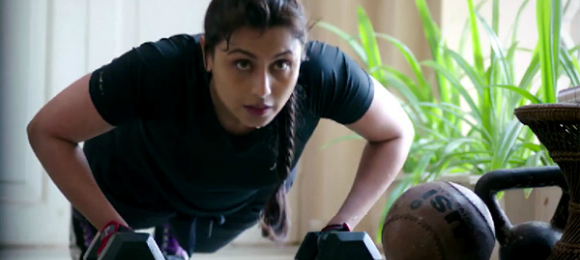Shivani Shivaji Roy (played by Rani Mukerji) is a senior inspector of the criminal branch in Mumbai.
Clever at picking up hidden clues and fearless in confronting hardened criminals after wild chases, Shivani takes on a life changing case.
A teenage girl, Pyari, who is like a daughter to her, is kidnapped by the trafficking mafia, and the mafia kingpin (played by Tahir Bhasin) smuggles her into world of cruel desires and exploitation.
What ensues is a cat and mouse game between a young, ruthless mafia kingpin and courageous cop.

Mardaani, the second collaboration of Sarkar and Mukerji post Laaga Chunari Mein Daag (2007), is straight to the point. There is no glitz, glam or fluff in the film but is true to the realistic portrayal of the sensitive message it is trying to convey.
It makes the audience aware, and angry, of the dark and filthy world of female trafficking.
Sarkar has previously been involved themes of female empowerment in films like Laaga Chunari Mein Daag and Lafangey Parindey (2010). However, in Mardaani, it is not a running theme but the entire message of the film.
Laaga Chunari Mein Daag was also to call girls but did not throw light on the dark, exploitative side of forced flesh trade.
[easyreview title=”MARDAANI” cat1title=”Story” cat1detail=”Mardaani delivered a sensitive issue in a powerful way. The rat and mouse game between the female police officer and a mafia kingpin keeps you captivated.” cat1rating=”3″ cat2title=”Performances” cat2detail=”Rani Mukerji excels once again as the main protagonist. The performances of the film are its strongest aspect.” cat2rating=”4″ cat3title=”Direction” cat3detail=”Although not a completely untouched topic for Sarkar, he gets into the raw details of the issue and allows the audience to feel emotionally connected with the film.” cat3rating=”3.5″ cat4title=”Production” cat4detail=”The production gets into the grittiness and filth of female trafficking.” cat4rating=”2.5″ cat5title=”Music” cat5detail=”Hardly any soundtrack to its credit but this is an advantage for the film.” cat5rating=”2″ summary=’Mardaani is a brave, hard-hitting film bringing out the harsh reality of female trafficking. Review Scores by Sonika Sethi.’ word=’ONE TO WATCH’]
The film does its best to show the matter as it is, or as raw as the censor board can allow it to. The portrayal of the harsh realities of human trafficking is conveyed through several intense episodes placed in the film.
These are scenes which may show too much for the audience’s liking but actually makes the film more powerful. In some scenes, it takes the audience out of their comfort zone and puts them right in the middle of the torment these young girls are going through.
This allows the audience to feel emotionally more connected with the film and empathise with the shimmering rage Shivani is undergoing in her journey to unravel this trafficking circuit.
Sarkar’s stance to side-track the soundtrack can be considered courageous, like much of the film. Having only one song at the end works well for the film, because it keeps the audience gripped into what is going on in the story.
The film could have done with perhaps another song to depict the emotions of the characters at times where emotions ran high, which has previously been utilised in other mystery thrillers, like Talaash (2012).
This would have slowed down the pace of the film slightly whereas Pradeep’s aim was to keep the audience highly engaged throughout Mardaani and this led to its short length. The song right at the end, the ‘Mardaani Anthem’, plays the purpose of reinstating the message of the film.
Despite a strong premise, the film adopts the standard route towards the climax. Although meant to show that there is light at the end of the murky tunnel, it is not completely realistic. Nonetheless, it leaves the audience with hope that such social evils can be tackled.
In terms of visualisation, Sarkar steers clear of graphic violence, avoiding excessive blood and gore.
The background score by Julius Packiam works well with the film and he doesn’t go overboard. However, it could be stimulated to a much greater extent to build-up a climax.
The Director of Production, Artur Zurawski, depicts the rough environment with striking visuals.
Rani plays this role to perfection, lending her character the much-needed intensity, strength and dignity.
She plays the character of Shivani Shivaji Roy realistically and is far from the floss and swagger of Chulbul Pandey and Singham. This is crucial in allowing the audience to take the film seriously.
Rani has shone in characters that have allowed her to take the lead and play the role distinctively, such as in Veer-Zaara (2004), No One Killed Jessica (2011) and of course, Black (2005).
When one thinks of an actress that can carry off a female-centric film, Rani is definitely high on the list.
Unlike the current crop of actresses like Sonakshi, Deepika and Katrina, Rani gives the character of Shivani Shivaji Roy the maturity, endurance and simplicity in the look desired. When one watches the film, they realise that no one could have played it better than Rani Mukerji.
Tahir Bhasin, who portrays the antagonist, leaves an intimidating impression despite being pitted against a powerhouse performer like Rani.
Mardaani has its heart in the right place and tells an important story at a time when it must be heard. One cannot miss Mardaani if they are even a slightest fan of Rani Mukerji, or if they are willing to take a no-nonsense film seriously.






























































